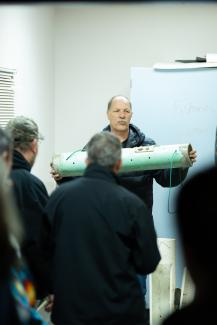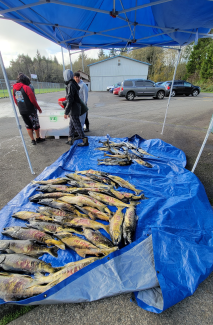Media Contact
Katy Payne she/her
360-764-0201
Taholah School District teacher Jerry Walther remembers the early days of the District's Career and Technical Education (CTE) program in Natural Resources.
"We started out making our own fish incubators," said Walther. "We drilled holes in PVC pipes and closed up the ends with screens to make sure fish could get out when they were ready, but nothing could get in."
Now, students in the CTE program in Natural Resources at the district's only school have access to underwater drones, 3D printers, and a state-of-the-art fish hatchery as part of their learning.
"I want my kids to have an edge," Walther said.
The program offers classes in different subject areas, including Forest Management, Fisheries, Ocean Marine, and Wetlands.
Part of the program's success can be traced to Walther's persistent efforts to secure tools and resources for his students, which has been supported by the Office of Superintendent of Public Instruction (OSPI). The school district received an Outdoor Learning Grant and The Clime Time Grant in February 2024 to purchase equipment and instructional materials, as well as provide professional learning opportunities. Taholah also received Environmental Literacy Grants from OSPI in 2021 and 2022.
"This grant supports specific community science projects," said Elizabeth Schmitz, Program Supervisor of Environmental and Sustainability Education at OSPI. "The work Jerry's doing is so important because it's based on the emerging needs of the community, and it also hones those 21st century learning skills of teamwork and communication."
Students in the program regularly get the chance to develop their skills, whether testing water samples, analyzing data, or monitoring salmon fry health.
"What really impresses me about the program is that the students are out and about, and it doesn't matter if it's raining or snowing, they're out at the river or the marina," said Taholah Principal Tescha Bailly.
Starting From Scratch

In 2012, the Taholah School District Superintendent approached Walther with the idea of starting a CTE program.
"We built everything up," he said.
Walther collaborated on the project with the Quinault Indian Nation's Division of Natural Resources, as well as researchers from the University of Washington, Western Washington University, and the University of Oregon.
"I developed the curriculum and the frameworks with the help of some really good people at OSPI," he said.
Taholah is a small coastal village about 40 miles northwest of Aberdeen on the Quinault Reservation. The reservation is a mix of towering conifer forests, winding rivers, and endless views of the Pacific Ocean.
"We have over 200,000 acres of classroom here," said Walther, who has been with the school district since the mid-1990s.
The Quinault Indian Nation is a federally recognized tribe comprised of the Quinault, Queets, Quileute, Hoh, Chehalis, Chinook, and Cowlitz peoples. A little less than 1,200 people live on the reservation, according to the most recent Census data.
Taholah’s school serves 182 elementary, middle, and high school students, according to data from the 2023–24 school year.
"We're a state school on tribal lands," said Walther. "Probably 98% of our students are Native American."
Small School, Big Impact
Students in the program do a little bit of everything, including working with the Tribe's Division of Natural Resources to monitor the invasive European Green Crab.
“We simply don't have the staff, and thank goodness, Jerry and his students were there to take this on for us,” said Scott Mazzone, Marine Fish and Shellfish Biologist for the Quinault Department of Fisheries within the Quinault’s Division of Natural Resources. “[The students] have trapped more than 1,700 of these crabs in the past couple of years.”
The state of Washington includes the European Green Crab on its list of Prohibited Level 1 Invasive species, meaning they "pose a high invasive risk and are a priority for prevention and expedited rapid response management actions.”
“These crabs like to burrow and dig up marsh grasses and eelgrass that are important for salmon and other species,” said Joe Schumacker, Marine Resources Scientist with the Quinault Department of Fisheries. “This is critical habitat and, once destroyed, could take years to reestablish, if ever.”
The environmental devastation wrought by the European Green Crab could also have a negative fiscal impact.
“The European Green Crab got established on the East Coast years ago, and they used to have a very productive soft-shell clam industry, and it's completely gone,” said Mazzone.
Walther’s students trap the crabs. They also count the number of males and females, as well as females with eggs.
The Tribe shares the information collected by the students with Washington state’s Department of Natural Resources (DNR), the Washington State Department of Fish and Wildlife, and others.
Using sophisticated equipment, Walther’s students collect temperature readings and test the acidification levels of rivers and the ocean. Research shows that warmer, more acidic ocean water is detrimental to marine life.
"We're using some of the same stuff the state and universities are using,” said Walther.
The work being done at the Taholah school has not gone unnoticed. Along with DNR, the National Oceanic and Atmospheric Administration (NOAA) and the Cascadia Research Collaborative have all worked with students on projects.
"The information our students collect informs decisions made locally in terms of where to release salmon," said Principal Bailly. "It can also be used to educate the entire state."
Helping Revitalize Salmon

Salmon are an integral part of Quinault and Washington culture. The iconic species faces many challenges including a changing climate. Currently, 14 species of steelhead trout, Chinook, coho, chum, and sockeye salmon, are listed as threatened or endangered in Washington state.
The Taholah school operates its own fish hatchery and collaborates with other hatcheries in the area, including Cook Creek, Penn Rearing, and Salmon River.
"The program concentrates on three species at a time, and right now, we're working with Chinook, chum, and coho," said Walther. “We released 240,000 coho as well as over 100,000 Chinook this year."
Students are involved in every step of the process, from spawning to incubation to release. Since the program's inception, Walther estimates that close to a million salmon have been released into local waterways.
"We're seeing salmon return to streams where we haven't seen salmon in years," he said.
Honoring the Past, Preparing for the Future
Innovation is baked into Taholah's Natural Resources program. Walther and his students use a salmon egg planter. The device mimics the motion a female salmon makes when creating its nest.
Honoring Tribal knowledge and expertise is also integral to the program and to the Quinault Nation.
“Looking at past practices of our Elders on raising techniques and releasing techniques of the salmon is very important to what we do,” said Walther.
The Quinault Nation has a long history of managing local fish stocks.
“The Quinault Nation is a self-regulating Tribe,” said Schumacker. “They’ve been managing their fisheries for a long time based on their own proven methods, and they've been doing it sustainably.”
Students in the CTE program learn important skills that can carry over into a career or a college classroom.
“We’re doing things that no one’s doing right now,” said Walther.
This knowledge is essential to Walther’s students' future and the future of the Taholah community. The village is grappling with arguably the most pressing challenge of modern life. Rising sea levels brought on by climate change mean the village has started relocating to higher ground.
Walther believes he has a responsibility to prepare students for a changing world. Taholah’s current students are also its future leaders. The skills they are building in Walther’s classes are already making a positive impact on Taholah and helping to ensure the community will continue to thrive.
“With teaching, I believe there's a mentality that we must stay in the box,” said Walther. “We need to think outside of the box, let our students make mistakes which helps them learn and grow.”






